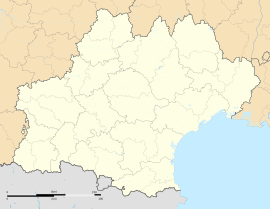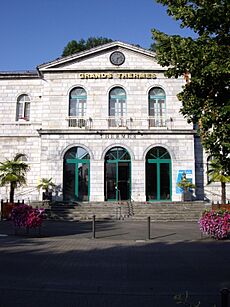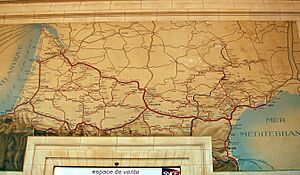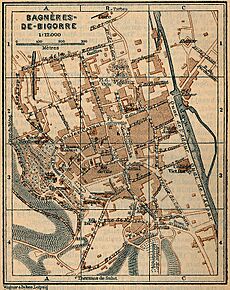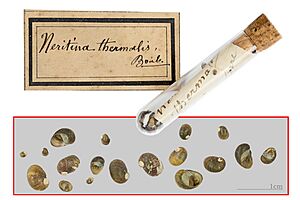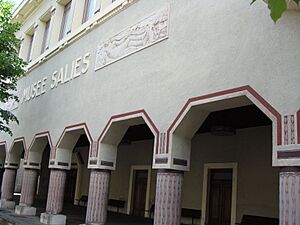Bagnères-de-Bigorre facts for kids
Quick facts for kids
Bagnères-de-Bigorre
Banhèras de Bigòrra (Occitan)
|
||
|---|---|---|
|
Subprefecture and commune
|
||
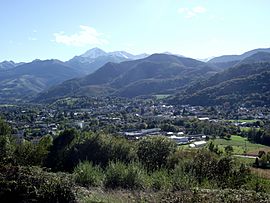
A general view of Bagnères-de-Bigorre
|
||
|
||
| Country | France | |
| Region | Occitanie | |
| Department | Hautes-Pyrénées | |
| Arrondissement | Bagnères-de-Bigorre | |
| Canton | La Haute-Bigorre | |
| Intercommunality | Haute-Bigorre | |
| Area
1
|
125.86 km2 (48.59 sq mi) | |
| Population
(2021)
|
7,000 | |
| • Density | 56/km2 (144/sq mi) | |
| Demonym(s) | Bagnérais(e) | |
| Time zone | UTC+01:00 (CET) | |
| • Summer (DST) | UTC+02:00 (CEST) | |
| INSEE/Postal code |
65059 /65200
|
|
| Elevation | 440–2,872 m (1,444–9,423 ft) (avg. 550 m or 1,800 ft) |
|
| 1 French Land Register data, which excludes lakes, ponds, glaciers > 1 km2 (0.386 sq mi or 247 acres) and river estuaries. | ||
Bagnères-de-Bigorre is a town in southwestern France. It is located in the Hautes-Pyrénées department, which is part of the Occitanie region. The town is known for its natural springs and its history as a spa town. Its name means "Baths of Bigorre."
Contents
- Understanding the Name of Bagnères-de-Bigorre
- The Coat of Arms of Bagnères-de-Bigorre
- Exploring the Geography of Bagnères-de-Bigorre
- A Look at the History of Bagnères-de-Bigorre
- Local Government and Administration
- Population Trends in Bagnères-de-Bigorre
- The Economy of Bagnères-de-Bigorre
- Culture and Heritage in Bagnères-de-Bigorre
- Famous People from Bagnères-de-Bigorre
- See also
Understanding the Name of Bagnères-de-Bigorre
In ancient times, this town was called Vicus Aquensis, which means "watery neighborhood" in Latin. Later, during the Middle Ages, it was known as Aquae Convenarum, meaning "Waters of the Comminges."
Today's name, Bagnères-de-Bigorre, also refers to its famous baths. "Banhèras" means "Baths" in the local Gascon dialect. "Bigorre" is the name of the area where the town is located. This area was once home to an ancient tribe called the Bigorri.
The Coat of Arms of Bagnères-de-Bigorre
The town's coat of arms shows a red (Gules) shield. On it are three silver (Argent) towers. The tower in the middle is taller than the other two. All the towers are surrounded by a silver wall. The details like the bricks, battlements, windows, and gates are shown in black (Sable).
Exploring the Geography of Bagnères-de-Bigorre
Where is Bagnères-de-Bigorre Located?
Bagnères-de-Bigorre sits at the foot of the Pyrenees mountains. It is partly in the valley of the Adour river. The town is about 18 kilometers (11 miles) southeast of Tarbes and 15 kilometers (9 miles) east of Lourdes.
Rivers and Waterways in Bagnères-de-Bigorre
The Adour river flows through the northeastern part of the town. It then heads north towards the Atlantic Ocean at Bayonne. Many smaller streams also flow through the area. These include the GaiVeste, Oussouet, Ardazen, Quartier par d'Abay, Lhécou, Garet, Adour d'Arizes, and Adour du Tourmalet. The Adour du Tourmalet flows through the hamlet of La Mongie and past the Castillon Dam.
Climate in Bagnères-de-Bigorre
The town's climate is influenced by the Pyrenees mountains. It gets a lot of rain, especially in spring, autumn, and winter. Summers are often hot and can have many thunderstorms.
 |
Pouzac | Hauban | Bettes |  |
| Labassère | Lies | |||
| Barèges | Vielle-Aure | Gerde |
A Look at the History of Bagnères-de-Bigorre
Ancient Times in Bagnères-de-Bigorre
The area of Bigorre was taken over by the Romans in 56 BCE. It became part of the Roman province of Gallia Aquitania. The Romans loved the natural springs of Vicus Aquensis (Bagnères-de-Bigorre). They built a settlement there. Later, the town was attacked by the Visigoths.
The Middle Ages in Bagnères-de-Bigorre
After the Franks defeated the Visigoths in 507 AD, there's not much information about the town until 1171. Some experts think the town might have been destroyed by an earthquake and then abandoned after a plague in 580 AD.
By 1171, the town had recovered. Centule III, the count of Bigorre, gave "Aquae Convenarum" a special charter. This document listed four villages protected by walls. By 1313, Bagnères was a busy place with about 800 taxable homes. It was a center for making and trading goods. Mills on the Adour river were used for grinding wheat, making tools, and tanning leather.
The Black Death arrived in 1348. During the Hundred Years' War, the English took control of the town in 1360. Another plague outbreak happened the next year. In 1427, the town was attacked and damaged by Henri de Trastámara, an ally of the French king. The town slowly rebuilt itself.
The Renaissance Period
Bagnères-de-Bigorre became even more important for trade. In 1551, King Henry III of Navarre changed the town's government. The town's natural springs became popular again thanks to Jeanne d'Albret, the queen of Navarre. Many important visitors came to use the baths.
Jeanne d'Albret became a Protestant in 1560. She tried to bring the Reformation to her lands. Most people in Bagnères remained Catholic. During the French Wars of Religion, the town suffered. It was ruined by the end of these wars. The plague also returned in 1588.
When Jeanne's son, Henry, became king of France in 1589, his titles, including count of Bigorre, joined with the French monarchy.
Early Modern Era in Bagnères-de-Bigorre
The plague hit Bagnères again in 1628, 1653, and 1654. People took steps to control it, like isolating patients. The disease disappeared after December 1654.
On June 21, 1660, strong earthquakes shook the town for three weeks. Only seven people died, but 150 houses were damaged. The natural springs temporarily dried up but soon flowed again. The town was rebuilt using special stones from the Salut Quarry. These stones could be polished to look like marble.
Using water for health (hydrotherapy) became very important. By 1787, there were 25 private businesses offering these treatments. In 1775, a building was turned into a gambling place called the Vaux-Hall, which also had dining and dancing. This was Bagnères' first casino.
The French Revolution and Industrial Growth
During the French Revolution (1789-1793), people seeking safety came to the city. From 1793, wounded soldiers were sent to spas like Bagnères. Several buildings were used as military hospitals.
In the 19th century, Bagnères' spas were known for helping with digestion. The town built a large public thermal spa, the "Thermes," which finished in 1828. By the 1870s, tourists would double the town's population during the "season." The casino also opened its own spa, the "Néothermes."
The marble industry became a major part of the local economy. The Géruzet marble works was one of the biggest in France from 1829 to 1880. In the 1870s, it employed a thousand people. Slate was also mined. The town also made woolen cloth, leather, pottery, and toys. A special light fabric called barège, made of silk and wool, was a local product.
Bagnères-de-Bigorre in the 20th Century
By the start of First World War, the town's population was about 7,000. The war led to more industry in Bagnères, especially in making railway parts. The marble industry declined, but mechanical and textile industries grew. The importance of hydrotherapy to the economy also lessened.
During the Second World War in June 1944, the town faced difficult times and suffered losses due to conflict.
After the war, the town grew quickly, especially in the 1960s. More homes were built, and the town expanded towards neighboring areas. Towards the end of the 20th century, industrial activity decreased. However, thermal spa visitors were still important. New jobs were created in healthcare, with a regional center for rehabilitation, a large retirement home, and a nursing home.
Local Government and Administration
Mayors of Bagnères-de-Bigorre
The town has had many mayors over the years. Here are some of the people who have led the town:
| From | To | Name |
|---|---|---|
| 1781 | 1784 | Jean-Baptiste Nicolas Pambrun |
| 1787 | 1790 | Dumoret |
| 1790 | 1791 | Lebrun |
| 1790 | 1790 | de Cazebonne |
| 1791 | 1792 | Etienne Xavier Salaignac |
| 1792 | 1794 | Pierre Guchan |
| 1794 | 1795 | Jean-Louis Rousse |
| 1795 | 1795 | Bonnet |
| 1795 | 1795 | Dabbadie |
| 1795 | 1797 | Jean-Jacques Gaye |
| 1797 | 1799 | Dussert |
| 1799 | 1799 | Jean-Jacques Gaye |
| 1799 | 1799 | Costallat |
| 1800 | 1801 | Jean-Marie Sarrabeyrouse |
| 1801 | 1806 | Etienne Louis Salaignac |
| 1806 | 1806 | Piera |
| 1806 | 1815 | Paul Alexandre de Joulas |
| 1815 | 1816 | Bertrand Pinac |
| 1816 | 1817 | Achille d'Uzer |
| 1817 | 1830 | Jean Alexandre Duffourc d'Antist |
| 1830 | 1831 | Jean-Pierre Dumont |
| 1831 | 1835 | Aristide Lasserre |
| 1835 | 1835 | Jean-Pierre Dumont |
| 1835 | 1838 | Aristide Lasserre |
| 1838 | 1842 | Louis Dumoret |
| 1842 | 1848 | Jean-Baptiste Dauphole |
| 1848 | 1848 | François Soubies |
| 1848 | 1848 | Ariste Pambrun |
| 1848 | 1870 | Clément Cyprien d'Uzer |
| 1870 | 1871 | Mathieu Gaye |
| 1871 | 1873 | Jean-Jacques Dumoret |
| 1873 | 1881 | Dominique Jean-Marie Cardailhac |
| 1884 | 1889 | Robert de Puysegur |
| 1889 | 1901 | Jean-Marie Dejeanne |
| 1901 | 1912 | Bertrand Fortassin |
| 1912 | 1914 | Louis Lafforgue |
| 1914 | 1915 | Jean Lhez |
| 1915 | 1918 | Jean-Marie Cougombles |
| 1918 | 1919 | Jean Lhez |
| 1919 | 1935 | Prosper Nogues |
| 1935 | 1941 | Henri Suberbie |
- Mayors from 1941
| From | To | Name |
|---|---|---|
| 1941 | 1944 | René Sühner |
| 1944 | 1945 | Joseph Domec |
| 1945 | 1958 | Joseph Meynier |
| 1958 | 1965 | Raymond Compagnet |
| 1965 | 1977 | André de Boysson |
| 1977 | 1989 | Eugène Toujas |
| 1989 | 2013 | Rolland Castells |
| 2013 | 2020 | Jean Bernard Sempastous |
| 2020 | 2026 | Claude Cazabat |
Town Twinning Programs
Bagnères-de-Bigorre is twinned with several towns around the world. This means they have special friendly relationships and often share cultural exchanges.
 Alhama de Granada (Spain) since 1995.
Alhama de Granada (Spain) since 1995. Granarolo dell'Emilia (Italy) since 1985.
Granarolo dell'Emilia (Italy) since 1985. Malvern (England) since 2016.
Malvern (England) since 2016. Tutzing (Germany) since 1975.
Tutzing (Germany) since 1975. Inverurie (Scotland) Since 2016.
Inverurie (Scotland) Since 2016.
Working Together: Intercommunality
The Community of communes of Haute-Bigorre (CCHB) was formed in 1994. Its goal is to help local towns work together on projects. They get funding from the government and Europe. Their work includes:
- Helping businesses grow.
- Providing services for older people, children, and those with disabilities.
- Protecting the environment.
- Managing waste collection.
- Improving housing.
- Planning land use.
- Promoting tourism.
Schools and Education
Bagnères-de-Bigorre has several schools. There are three kindergartens and six elementary schools. For older students, there are the Colleges of Blanche Odin and Saint Vincent. The Victor Duruy high school also serves the area.
Population Trends in Bagnères-de-Bigorre
| Historical population | |||||||||||||||||||||||||||||||||||||||||||||||||||||||||||||||||||||||||||||||||||||||||||||||||||||||||||||||||||
|---|---|---|---|---|---|---|---|---|---|---|---|---|---|---|---|---|---|---|---|---|---|---|---|---|---|---|---|---|---|---|---|---|---|---|---|---|---|---|---|---|---|---|---|---|---|---|---|---|---|---|---|---|---|---|---|---|---|---|---|---|---|---|---|---|---|---|---|---|---|---|---|---|---|---|---|---|---|---|---|---|---|---|---|---|---|---|---|---|---|---|---|---|---|---|---|---|---|---|---|---|---|---|---|---|---|---|---|---|---|---|---|---|---|---|---|
|
|
||||||||||||||||||||||||||||||||||||||||||||||||||||||||||||||||||||||||||||||||||||||||||||||||||||||||||||||||||
| Source: EHESS and INSEE | |||||||||||||||||||||||||||||||||||||||||||||||||||||||||||||||||||||||||||||||||||||||||||||||||||||||||||||||||||
The Economy of Bagnères-de-Bigorre
The town's economy mainly focuses on manufacturing. In the past, it included making railway materials. Today, the main activities are hydrotherapy (water treatments) and tourism.
Local Industries
Bagnères-de-Bigorre has many small and medium-sized businesses. They specialize in electrical equipment, mechanical parts, and aerospace industries. There are four main business zones:
- The Dominique Soulé Business Park has 14 companies, including CFD Bagnères (railway), Novexia, and Nouvelle Bagnères Aéro.
- The Adour Industrial Zone has 23 companies, such as Electraline CBB and Adour Industries.
- The Haute-Bigorre Business Park has 9 companies, including Areva T & D and Amare Charpentes.
- The Haute-Bigorre Industrial Park has 3 companies, like ABB Soulé Surge Protection.
Hydrotherapy and Tourism
The Grands Thermes de Bagnères-de-Bigorre (Grand Thermal Baths) use natural spring waters. These waters are used to treat conditions like rheumatism and indigestion. The water temperature ranges from 32°C to 57°C (90°F to 135°F).
Like many spa towns, Bagnères-de-Bigorre has a casino. It is in the same building as the Aquensis thermal spa. The ski resort of La Mongie is also close by, offering winter sports.
- Thermalism and tourism gallery
Getting Around: Transport
The D935 road goes through the town, connecting it to Tarbes and Beaudéan. The D938 goes north to Tournay. The D918 passes through the southeast, including the hamlet of La Mongie.
The railway line that connected Bagnères and Tarbes closed in the late 1980s. Now, buses provide service from the old railway station. The nearest airport is Tarbes-Lourdes-Pyrénées Airport, about 30 kilometers (19 miles) north.
Culture and Heritage in Bagnères-de-Bigorre
Important Historic Buildings
The town has several buildings that are protected as historical monuments:
- The Uzer House (17th century).
- The Jean d'Albret House (1539).
- The Tower of the Jacobins (14th century) is a tall, Gothic-style tower. It is what remains of an old Dominican monastery.
Religious Sites
Two religious buildings are also protected historical monuments:
- The old Church of Saint John Portico (1280).
- The Church of Saint Vincent (1557) was built on an even older church site. It has a mix of Gothic and Renaissance styles. Inside, you can find historical items like confessionals, a baptismal font, and an altar.
Bagnères-de-Bigorre gallery
Natural Wonders
- The Grottes de Médous (Médous caves) are natural caves that visitors can explore. They are also a place for religious pilgrimages.
- Bagnères-de-Bigorre is where a special type of snail, Theodoxus fluviatilis thermalis, was first described.
Museums to Visit
The town has three museums:
- The Salies Museum of Fine Arts is located under the old thermal baths.
- The Salut Natural History Museum teaches about local nature.
- The Marble Museum, opened in 2007, displays over 300 large samples of European marble.
Cultural Activities and Events
Bagnères-de-Bigorre has several cultural places, including a Multimedia library and a Municipal Cultural Center. The town also hosts many cultural events:
- The Piano Pic Festival
- Chopin in Bagneres
- The Weekend of Street Art
- The À Voix Haute Music Festival
- The High school girls video meeting
- The Pyrenees Book Fair
The town has an orchestra called the Harmony Bagnéraise and a choir called La chorale des chanteurs montagnards.
Sports and Recreation
The Stade Bagnérais is a local rugby union club. They have played in France's top division and reached the championship final twice.
Bagnères has many sports clubs and facilities:
- Four gymnasiums.
- The Apollo Hall for Dojo (martial arts).
- The André Boysson Swimming pool.
- Rugby and soccer fields.
- Indoor and outdoor tennis courts.
- A Municipal Equestrian Center for horse riding.
- The Bigorre Golf Course (in Pouzac).
- An Artificial whitewater course on the Adour river.
- A Fronton for Basque pelota.
- A Skatepark.
- The Bédat Shooting Range.
- Many mountain activities in the Tourmalet area.
Bagnères-de-Bigorre has also been a stage finish for the famous Tour de France cycling race in 2008 and 2013.
Places of Worship
The Parish of Bagneres-de-Bigorre includes 17 towns in the diocese of Tarbes and Lourdes. The Petit-Rocher Carmel is a community of nuns founded in 1833. There is also a Reformed Church temple built in 1857.
Famous People from Bagnères-de-Bigorre
Many notable people have connections to Bagnères-de-Bigorre:
- The Bédat Family came from Bagnères-de-Bigorre.
- André Joseph Boussart (1758–1813): A general in the French armies.
- Alfred Roland (1797–1874): A composer.
- Marie-Armand d'Avezac de Castera-Macaya (1798–1875): An archivist and geographer.
- Charles Dancla (1817–1907): A violinist and composer.
- Charles Duclerc (1812–1888): A politician.
- Admiral Sir Albert Hastings Markham (1841–1918): A British explorer.
- Dominique Soulé (1847?-?): Founded a railway materials company.
- Blanche Odin (1865–1957): A painter.
- Julián Bourdeu (1870–1932): A journalist and police official in Argentina.
- Marcellin Duclos (1879–1969): An opera singer.
- Field Marshal Sir Alan Brooke (1883–1963): A British Army officer.
- Pierre-Georges Latécoère (1883–1943): An industrialist.
- Pierre Lamy de la Chapelle (1892-1944): A pioneer of the La Mongie ski station.
- Tony Poncet (1918–1979): An opera singer.
- Jean Gachassin (1941–): A former French rugby player.
- Jean-Louis Bruguès (1943–): An Archbishop.
- Roland Bertranne (1949–): A former rugby player.
- Jean-Paul Betbeze (1949–): An economist.
- Jean-Michel Aguirre (1951–): An international rugby player.
- Yves Duhard (1955–): A rugby player.
- Wilfrid Forgues (1969–) and Frank Adisson (1969–): Olympic champions in Canoeing.
- Sophie Theallet (1964–): A fashion designer.
- The Société Ramond: A scientific society founded in 1865.
- Tony Hawks: An English writer and comedian, who bought a house nearby.
|
See also
 In Spanish: Bagnères-de-Bigorre para niños
In Spanish: Bagnères-de-Bigorre para niños




